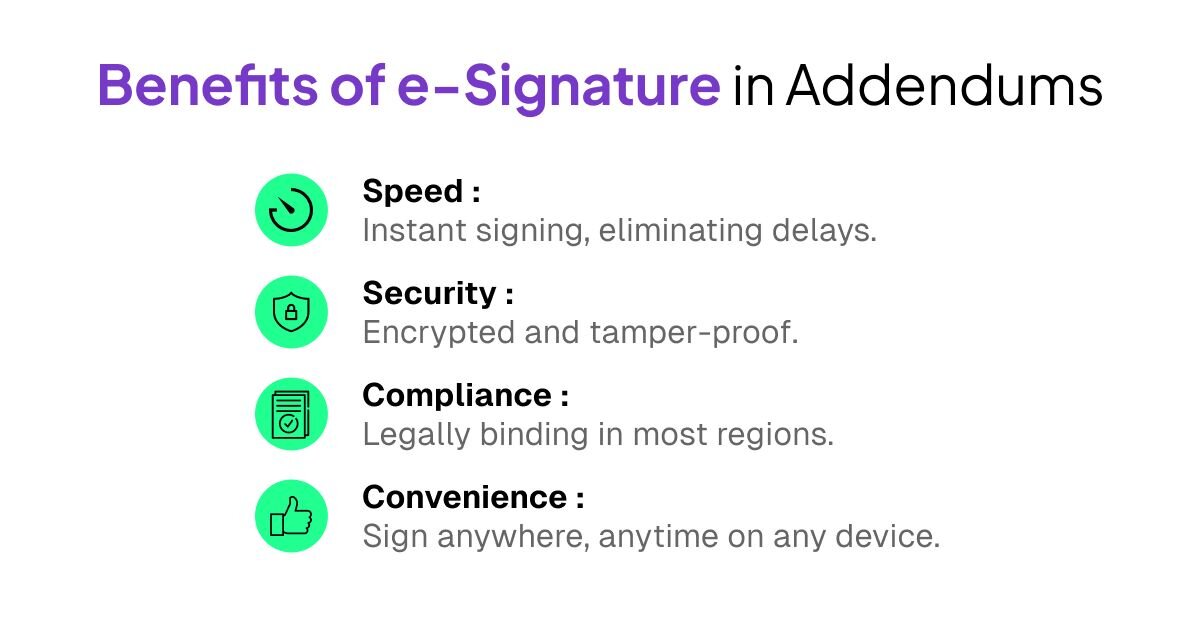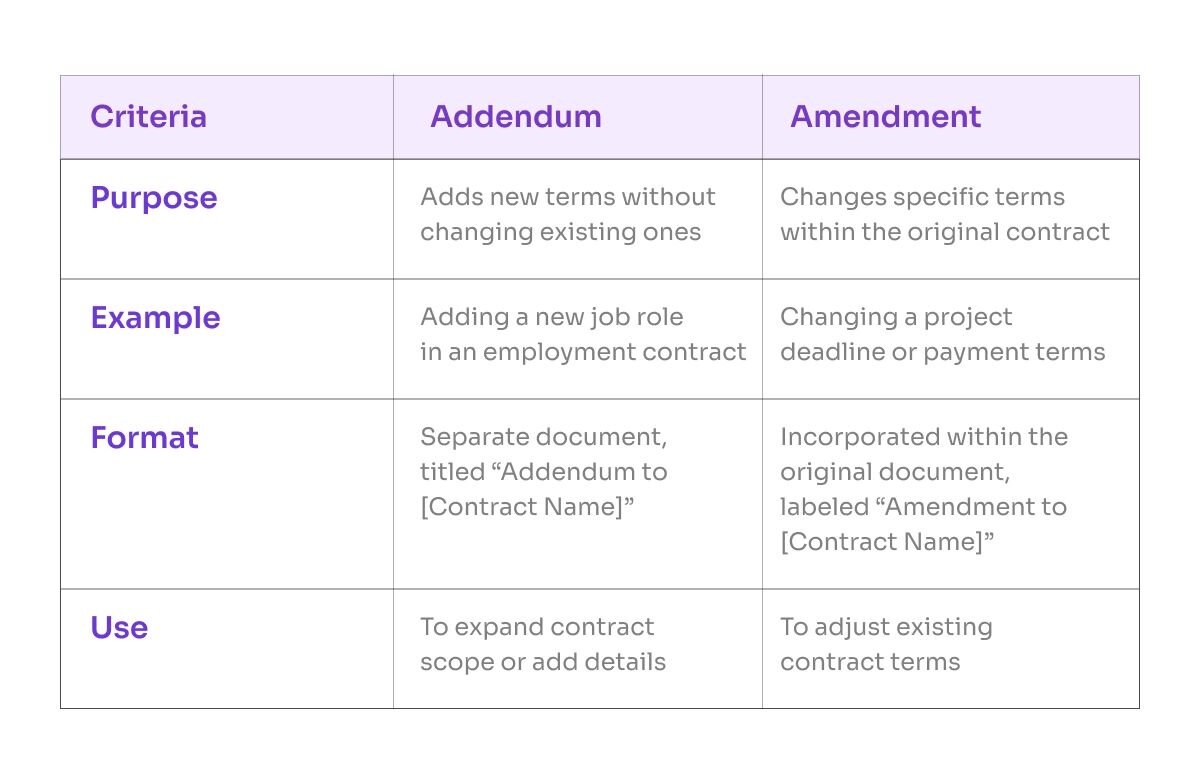In the world of contracts, change is inevitable. Business agreements often need adjustments to reflect evolving needs, goals, or responsibilities. Rather than redrafting an entire contract, companies use an addendum agreement—a separate document added to the original contract to update or extend its terms. An addendum keeps contracts relevant without losing the foundational terms and agreements both parties initially agreed upon.
Crafting a strong addendum to contract documents requires precision and clarity, ensuring that any additions or modifications are seamlessly incorporated.
Additionally, with the rise of digital technology, many businesses are now opting for e-signatures to finalize addendums. This not only adds convenience but also boosts efficiency and security. In this guide, we’ll walk through the essentials of drafting an addendum and explore the role of e-signatures in making the process quicker and more reliable.
What is Addendum Agreement?
An addendum is a supplemental document attached to an original contract that outlines additional terms or modifications to the initial agreement. An addendum differs from an amendment, which modifies existing clauses in the original contract. In contrast, an addendum agreement adds new clauses that don’t alter the core terms but enhance or clarify them.
Common Situations Requiring an Addendum
An addendum to a contract can be useful in several scenarios, such as:
- Extending Project Scope: When a project needs to expand beyond the original scope, an addendum agreement can clarify new deliverables, timelines, or resources without altering the initial contract.
- Adjusting Deadlines or Payment Terms: In real estate or service agreements, parties may need to push back deadlines or update payment schedules, which an addendum agreement can formalise.
- Updating Responsibilities: Employment contracts might require an addendum to document new responsibilities, benefits, or roles for an employee.
Each of these scenarios shows how addendums serve as practical tools for maintaining the relevance of contracts while preserving the integrity of the original agreement.
The Importance of E-Signatures in Addendums
With the shift towards digital processes, e-signatures have become essential in contract management, especially for addendums. E-signatures simplify the process by allowing parties to sign and approve documents remotely, without the need for in-person meetings or physical paperwork. Here’s why they’re so valuable:
Efficiency and Speed
Traditional signing processes can take days or weeks due to mailing times and coordination of schedules. With e-signatures, an addendum letter or addendum format can be sent, signed, and finalized within hours.
Legal Compliance and Security
E-signature platforms typically follow stringent security measures, such as encryption and audit trails, that protect signed documents. In most jurisdictions, digitally signed documents hold the same legal weight as traditional pen-and-paper signatures.
Record Keeping
E-signature tools provide an organized way to store and access signed addendums, ensuring documents are easy to retrieve and trace back for verification. With online contract signing, both parties can quickly and securely agree on addendum to contract terms, making it an invaluable tool in today’s fast-paced business environment.
To learn more about electronic signatures, click here.
7 Easy Steps to Write an Addendum
To create an effective and enforceable addendum, follow these seven straightforward steps:
1. Mirror the Original Contract Language
Consistency is essential. Use similar formatting, tone, and structure as the original contract to make the addendum agreement feel like a natural extension of the original terms. This helps avoid confusion and reinforces that the addendum is linked directly to the original document.
2. Choose a Clear Title
Your title should indicate that the document is an addendum to the original contract. A good example might be, “Addendum to Employment Agreement Dated [Date]” or “Addendum to Contract for Services Between [Parties].” This helps avoid misunderstandings.
3. Specify the Parties Involved
Clearly identify all parties to the contract in the addendum format. Make sure the details align with the original contract to eliminate any ambiguity about who the addendum to contract applies to.
4. Reference Specific Clauses
If the addendum clarifies or builds upon specific clauses in the original contract, cite them. For instance, you could write, “This addendum supplements Section 5.2 of the original agreement regarding project deadlines.” This keeps the context clear and prevents disputes about the addendum’s intent.
5. Ensure Compliance with the Original Contract and Legal Requirements
Verify that the addendum aligns with the terms and requirements of the original contract. Some contracts specify that amendments or addendums must be in writing, so it’s crucial to follow these requirements. Additionally, make sure your addendum complies with any legal regulations to avoid enforceability issues.
6. Include E-Signature Options
Offering online contract signing options ensures the process remains smooth and efficient. E-signatures streamline the online agreement signature process and enable both parties to sign remotely, which is particularly helpful for time-sensitive agreements. Many platforms provide added security, such as unique identifiers and encrypted storage.
7. Seek Legal Advice if Necessary
If the addendum agreement involves complex changes or legalities, consulting with a legal professional is advisable. This ensures the document is sound, enforceable, and that you’re in full compliance with local laws and regulations.
Addendum vs Amendment
When updating contracts, knowing whether to use an addendum vs amendment can simplify the process:
- Addendum: Used when adding new, distinct terms to a contract. For example, if a company wants to expand a project’s scope without altering the original terms, an addendum would be appropriate.
- Amendment: Modifies existing terms or clauses. For example, changing the payment structure or deadline in the original document. Amendments are best for changes to the core terms of the contract rather than adding new, unrelated terms.
The choice of addendum vs amendment depends on the type of change needed. By understanding the difference, businesses can use the correct document and avoid unnecessary complications.
Common Scenarios for Using Addendums
Addendums are widely used across industries to adapt contracts to changing needs. Here are a few key examples:
Employment Contracts
An employer might issue an addendum to update an employee’s job responsibilities, salary, or benefits. This addendum letter maintains the original terms but adds specific, new conditions.
Real Estate Transactions
Addendums are commonly used to adjust timelines or address issues discovered during inspections. Online contract signing tools allow buyers and sellers to sign addendums quickly, enabling faster transactions.
Insurance Policies
Adding additional coverage or adjusting terms can be managed with an addendum to contract. E-signatures expedite the process, making it easier for clients to accept new terms without delays.
Construction Contracts
Contractors might use an addendum agreement to outline scope changes, budget modifications, or timeline adjustments. Digitally signed documents ensure these changes are documented and easily enforceable.
Licensing Agreements
When licensing terms change, such as expanding the rights to a product or technology, an addendum format can capture the new terms without rewriting the original agreement.
In each of these scenarios, using e-signatures enhances efficiency, allowing all parties to finalize adjustments swiftly.
To learn more about the different types of contracts, click here.
Conclusion
Writing a clear, effective addendum agreement keeps contracts adaptable and ensures all parties remain aligned on updated terms. By following best practices in language, structure, and compliance, you can create a strong addendum that supports the original contract without conflicting with its terms. E-signatures further simplify the process, adding speed, security, and ease to contract management.
As you manage your next contract adjustments, consider incorporating e-signature solutions to streamline the experience. These digital tools provide a compliant, efficient way to handle online agreement signing, making contract management faster and more organized.
Explore our eSignature platform today!
Frequently Asked Questions
1. What is the difference between an addendum and an amendment?
An addendum introduces new terms to a e contract, while an amendment changes existing terms in the original document. Both are used to modify agreements but in distinct ways.
2. How to enforce an addendum in a contract?
To enforce an addendum to e contract, ensure it is written, signed by all parties, and compliant with the original contract terms and legal requirements. E-signatures provide added security for enforcement.
3. Can an addendum be verbal, or does it need to be written?
While verbal addendums may be legally valid in certain situations, a written and signed addendum is more reliable and easier to enforce. A digitally signed document provides a secure, verifiable record of the agreed terms. By leveraging e-signature solutions, you can simplify the addendum process, ensuring changes to your e contract are handled smoothly and efficiently.

